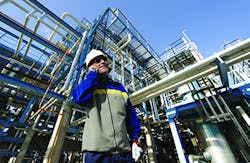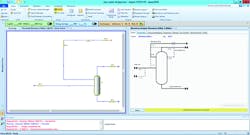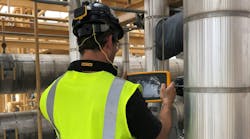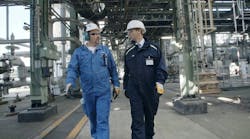Staying on schedule with plant safety design is fundamental in the oil and gas, chemical, and petrochemical industries. To be compliant, stay cost-effective and meet project deadlines, organizations need to eliminate issues that arise with safety projects such as timeline bottlenecks, allowing engineers to improve workflows and reduce project cycle time. Additionally, improved, integrated safety tools and processes enable engineers and construction industry professionals to serve more clients, while maintaining stringent safety standards. Currently, advanced solutions are available to address these issues and bottlenecks, but many companies still rely on traditional, manual methods to design their process safety systems and use internal, rudimentary tools to deliver them. This suboptimal workflow can introduce inaccuracies, which may result in a dangerous and costly project design.
Engineers need to equip themselves with the right tools to elevate their safety expertise and allow them to respond quickly, cost-effectively and safely in any situation. With cutting-edge software, engineers can increase accuracy to save time and money.
Minimizing costs with a software solution
Greater accuracy saves time and money. Achieving greater safety saves lives. With cutting-edge blowdown software, detailed analysis and protection of key process equipment can be performed more quickly and effectively including rigorous and rapid depressurization studies.
With the right tools, performing the most accurate minimum design metal temperature (MDMT) analysis reduces costs while ensuring that the materials of construction will not fracture. Determining the certainty of values is imperative to avoid unnecessary expenses and preclude the risk of overly conservative specifications. For a comprehensive end-to-end depressurization solution, robust blowdown simulation software assists oil and gas companies in every process engineering project, ranging from newly built facilities, to a revamped project on an existing process and design, or to rate blowdown systems that ultimately ensure proper safety and are economically feasible.
For engineers, better modeling of temperatures, pressures and maximum flow rates during the blowdown process reduces overdesigning the system and saves engineering costs. Accurately depressurizing the system minimizes the risk of harm to personnel, the process equipment and the product. Ensuring that this analysis determines the safe materials of construction and provides the correct orifice sizes to depressurize the systems is also critical and in accordance with leading industry standards, such as those of the American Petroleum Institute (API) and NORSOCK for fire cases.
With advanced simulation tools, engineers can create concurrent designs with simulation, which minimizes reworks, enabling engineers to reuse and refine the safety analysis at each stage of the design life cycle. In addition, they have complete control to push assets to the limit to maximize throughput and troubleshoot efficiently with confidence and more accuracy while conducting safety analyses.
Blowdown software technology was recently integrated with a process simulation tool that allows engineers to determine orifice sizes and pinpoint areas of low temperature concerns, providing less conservative MDMT values. In some cases, this can lead to three to four times the cost savings resulting from less expensive materials of construction. The software has been used in more than 400 projects in oil and gas and chemical companies to model
depressurization.
The software identifies specific locations in a system at which temperatures may decline dramatically during depressurization. With these enhanced safety features, engineers can best serve workflows and safety projects, perform accurate safety analysis, and leverage data from simulators all within one integrated engineering simulation environment.
Saving time with an integrated solution
With advanced process safety software, users have the tools to ensure that proper pressure safety valve sizing is used throughout the pressure relief analysis.
In addition to costs, time is another expense within any organization. Safety design often includes a manual workflow requiring laborious data transfer between tools. While some organizations continue to use traditional tools such as Microsoft Excel, they are finding that these processes are time-intensive and can lead to inaccuracies during data collection. With an integrated solution, companies and engineers have the tools to make more effective use of their time.
For example, many companies have adopted advanced engineering software solutions to rigorously improve front-end engineering design (FEED) and perform revalidation studies to find capital savings and improve process safety and reliability. The best process safety software tools offer multiple options to complete pressure relief analysis projects. Engineers can use these tools to easily conduct safety studies — including pressure safety valve sizing; depressurization; flare system design and rating; and dynamic analysis for startup, shutdown, emergencies and compressor surge with the option to use simulation data from integrated engineering application environments.
By incorporating safety analysis solutions within engineering software suites, users can leverage the thermodynamic engine when completing pressure relief analysis projects and quickly add and size relief valves early in the design process to include industry standards — such as API 520, 521 and 2000 — in their calculations. This pressure relief analysis can be further used to discharge those sized relief devices by automatically importing sized pressure safety valve results into flare analysis software to streamline pressure relief analysis. Leveraging dynamic models during analysis helps avoid the risk of overly conservative or potentially more expensive designs by thoroughly examining the whole system.
Integrated software solutions improve relief load calculations for FEED and revalidation projects. The best engineering tools include these enhancements to reduce the time required to conduct pressure relief analysis workflows and improve the analysis’ accuracy by eliminating manual data transfer and subsequent transcription errors. Ultimately, with process safety software tools, engineers gain many benefits, which include:
The software offers a faster, easier way to view results with clear and informative visuals through preconfigured graphs and reports.
- Decreasing engineering time by up to 50 percent
- Reducing mistakes during manual transfer to ensure data accuracy
- An increased ability to integrate results into flare system models
- An increased scope of relief load calculations
- Avoiding unnecessary capital investments that occur with under-designs or overdesigns
- Avoiding the consequence of inaccurate pressure safety valve sizing
- Upholding quality safety standards
- The ability to model multiple scenarios
- Automated regulatory reports and documentation for compliance
- Tools that support engineering knowledge and ease of use
Hunt, Guillot & Associates (HGA) — a midsize engineering and construction firm that performs project work in engineering, pipelines and program management/emergency recovery — recently upgraded its integrated, single unified platform of engineering solutions in an effort to boost its ability to efficiently complete relief sizing. HGA’s engineering division’s work expanded with increasing design complexity, generating the need for a superior engineering environment.
HGA’s process department performs overpressure protection analysis as a regular part of the process design workflow. An obstacle the team faced was a lack of commercial products for pressure safety device sizing. This required a more tedious work process that involved separate calculations for overpressure protection performed with additional software not used for the process modeling work. This coincided with an increase in project work during the previous two years because HGA serves the rapid-paced unconventional oil and gas industry in North America.
By integrating an advanced pressure safety valve sizing tool into the organization’s engineering suite, the team was able to eliminate the time-consuming custom calculations, analyze multiple overpressure scenarios systematically and reduce the time required to size relief valves by 50 percent.
Moving forward with process safety
Safety is the mainstay of any sustainable business. Ultimately, risk is managed by identifying hazards quickly, assessing consequences and probabilities, and implementing effective mitigation measures. As plants and other facilities become increasingly complex, organizations can manage this risk by successfully adopting advanced integrated safety engineering software for more effective management and overall improved operational conditions.
Additionally, as organizations continue to standardize integrated safety environments, they will have the tools to conduct analyses faster and easier for greater accessibility to users of all levels of expertise, which leads to safer designs and reduced maintenance costs.
By adopting easy-to-use process safety software as part of an integrated engineering application environment, engineering teams will improve safety performance across their operations, increase accuracy to save time and money, and ultimately achieve the highest standards in operational excellence.
Katherine Hird is a product expert in process safety with a focus on dynamic simulation, relief valve sizing, depressurization and flare products at AspenTech. Hird holds a degree in chemical engineering from the University of New Hampshire.




